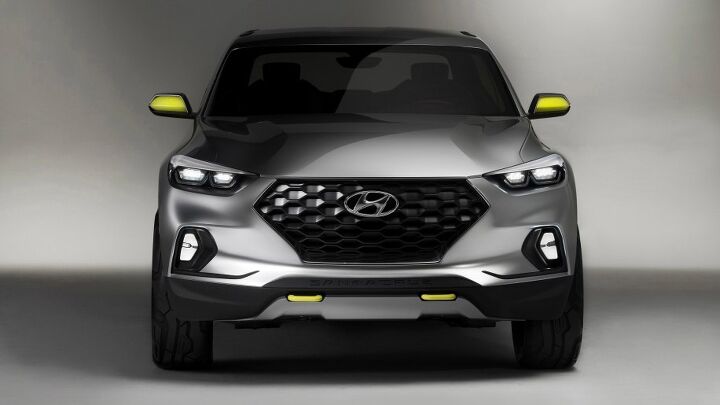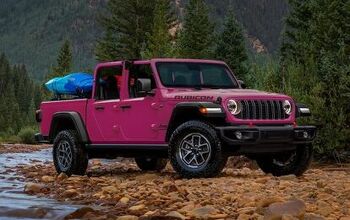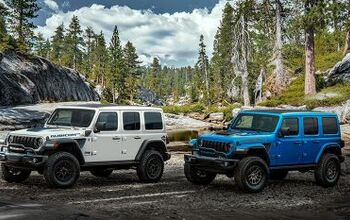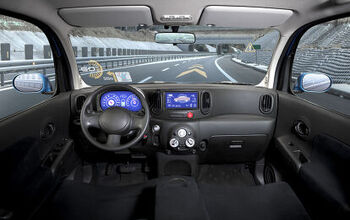Hyundai Hopes to Solve U.S. Sales Woes With Slick Little Pickup

Hyundai intends to launch a small pickup truck in the United States as part of its plan to catch up with the industry’s shift away from sedans. Up until now, that strategy has involved cramming as many SUVs onto the market as possible. But Hyundai brand sales are still dragging behind 2016’s monthly averages in the U.S., with end-of-year estimates falling short of company goals.
The solution is to keep pushing the Tucson, start deliveries on the Kona mini SUV before 2018, and begin development of a pickup truck based on the Santa Cruz concept from 2015 (seen above). Hyundai is also rumored to be planning on adding three additional sport utility vehicles or crossovers to its North American lineup by 2020 — helping it shore up waning sedan and hatchback sales.
As small trucks don’t arrive in the U.S. market with any regularity, this is rather exciting news. Assumedly, the Hyundai pickup will be assembled in the United States to avoid the dreaded chicken tax. Otherwise, the Korean automaker might as well spend its money funding a space program to shoot its remaining capital into the sun. Its massive SUV pant in Alabama seems like the best choice — however, that facility is already operating at capacity, leaving little room for another vehicle.
Regardless, Michael J. O’Brien, vice president of Hyundai’s corporate and product planning, told Reuters that the automaker is a go for development on a pickup truck similar to the Santa Cruz. Like the concept vehicle, the production version will probably attempt to bridge the gap between car and truck as a North American ute. The odds of it using the Santa Cruz’s 2.0-liter diesel (making 190 horsepower and 300 lb-ft of torque) are doubtful, however. We expect to see a turbocharged gasoline engine and a hybridized variant instead.
The pickup’s size is also up for questioning. While having it based off the show car would make it significantly smaller than most of North America’s offerings, building it too small could be a sales curse. Likewise, going too large would place it up against industry veterans like the Ford F-150. Realistically, it’ll probably find itself in direct competition with Honda’s Ridgeline — which has carved out a niche for itself without becoming an overt sales magnet — whether it’s a little bigger or smaller than its unibody rival.
Hyundai is green-lighting the pickup into development mainly because of the overwhelmingly positive feedback received from the Santa Cruz. Uniqueness had a helping hand in that, so going too mainstream likely isn’t in the cards. But this is a small truck best suited for hauling furniture and weekend excursions, not the mammoth junk-haulers Americans buy in droves. While we like the idea of a spiritual successor to the Subaru BRAT, the rest of the sales region may not. Can it really help influence Hyundai’s sales figures?
“Our glasses are fairly clean,” O’Brien said. “We understand where we have a shortfall.”
The brand’s 2017 U.S. sales are down nearly 11 percent through the end of July, with the Sonata losing 30 percent during those first seven months. But Hyundai’s current SUV lineup is up 11 percent during the same timeframe and dealers have noticed. They’ve been begging the automaker to provide them with as many SUVs and trucks as the company can muster.
“We are optimistic about the future,” Scott Fink, chief executive of Hyundai of New Port Richey, Florida, said. “But we are disappointed that we don’t have the products today.”
[Images: Hyundai]

A staunch consumer advocate tracking industry trends and regulation. Before joining TTAC, Matt spent a decade working for marketing and research firms based in NYC. Clients included several of the world’s largest automakers, global tire brands, and aftermarket part suppliers. Dissatisfied with the corporate world and resentful of having to wear suits everyday, he pivoted to writing about cars. Since then, that man has become an ardent supporter of the right-to-repair movement, been interviewed on the auto industry by national radio broadcasts, driven more rental cars than anyone ever should, participated in amateur rallying events, and received the requisite minimum training as sanctioned by the SCCA. Handy with a wrench, Matt grew up surrounded by Detroit auto workers and managed to get a pizza delivery job before he was legally eligible. He later found himself driving box trucks through Manhattan, guaranteeing future sympathy for actual truckers. He continues to conduct research pertaining to the automotive sector as an independent contractor and has since moved back to his native Michigan, closer to where the cars are born. A contrarian, Matt claims to prefer understeer — stating that front and all-wheel drive vehicles cater best to his driving style.
More by Matt Posky
Latest Car Reviews
Read moreLatest Product Reviews
Read moreRecent Comments
- ToolGuy I might be Batman.
- Lou_BC Well, I'd be impressed if this was in a ZR2. LOL
- Lou_BC This is my shocked face 😲 Hope formatting doesn't fook this up LOL
- Lou_BC Junior? Would that be a Beta Romeo?
- Lou_BC Gotta fix that formatting problem. What a pile of bullsh!t. Are longer posts costing TTAC money? FOOK





































Comments
Join the conversation
I thought a Honda Ridgeline would do until I looked at one. Nice, but too big. I may be too used to wait for a Hyundai or other small pickup. Maybe find a 2003 or so Tacoma, like the one I once had, and rebuild what needs rebuilding.
I an excited about this vehicle because I look forward to watching all the "Need moar small trucks, I'll be first in line to buy one" people I know tie themselves in knots coming up with nit-picking reasons not to actually buy one.